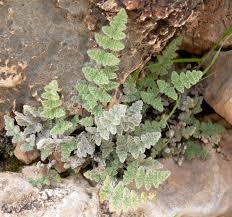Ferns in the desert? You must be kidding right, ferns live in shady, damp areas like steamy tropical rain-forests or old growth conifer forests of the Pacific northwest. But the desert, come on now.
A quick google search for desert ferns actually reveals a surprising diversity of desert and semi-desert ferns. Wait...what...ferns in the desert?
 |
| Chihuahua Mexico.Various desert ferns. Kirkland (c) 2006 |
Often referred to as chelanthoids, desert ferns are true xeric ferns showing a variety of adaptations towards reducing water loss. These adaptations include smaller leaf size, fewer and sunken stomatal crypts, waxy covering, hairs, curling during dry spells and the ability in some species to completely desiccate and return to life with favorable conditions. Found in both the old and new world, a hotspot of diversity for chelanthoid ferns is the southwestern deserts of North America.
 |
| Cheilanthes parryi |
The ability of these desert ferns to blend in and seemingly remain unnoticed belies there wonderful and particular desert adaptions. They often grow in rocky crevasses of specific rock types (limestone, quartz) or on the north side of rocks. cacti etc- little tiny microhabits within the desert landscape that capture that tiny little bit of extra moisture. Although never a dominant part of their landscape, cheilanthoids are surprisingly diverse at several hundred species. There radiation into xeric habits has not gone unnoticed as a potential model for how ferns may have played important roles in dry habitats during the Mesozoic (Kirkland, 2006). Indeed prior to the advent of angiosperms a diverse community of ferns and other plants such as club mosses likely would have served as the dominant groundcover plants during the Mesozoic in dry or seasonally dry habitats. We think of modern ferns as water loving or mesically adapted plants because angiosperms for the most part have taken over their former habits.
 |
| NPS. Cookie Ballou (c) |
If I can be so bold as to imagine what these fern prairies or fern savannas were like my one word would be diversity. From my experience with ferns I have noticed that ferns will do very good, and need minimal care if they are in the right spot with the right light, soil, pH, etc etc- if not they will not succeed. And I believe this is a valid point to bring in when trying to imagine these fern dominated habitats- you would not see monotypic plains of one or even several species of ferns thriving like you do with grasses in modern prairies. Instead you would notice several dozens of species thriving in a mosaic fashion. Some would be like bracken fern, thriving in full sun in disturbed areas spreading with rhizomes. Some would be always associated with other plants, perhaps thriving on the north face of larger cycads. Some would be quite ephemeral and die back with drought conditions.
 |
| Astrolepsis cochisensis on limestone ridge. Mineralarts |
And diversity was one of the key selling points for the
recent naming of a genus of cheilanthoid fern after Lady Gaga. That and the bisexual nature of the ferns reproductive mode and that this species DNA base codes spell out G-A-G-A.
 |
| Lady Gaga and fern gametophyte. Duke Univesrsity (c) |
Cheers!!!
Pertinencia
http://tolweb.org/cheilanthoids/133070
Krkland, James. Fruita Paleontological Area. 2006. New Mexico Museum of Natural History Bulletin.
Fern spore diversity and abundance in Australia during the Cretaceous
No comments:
Post a Comment